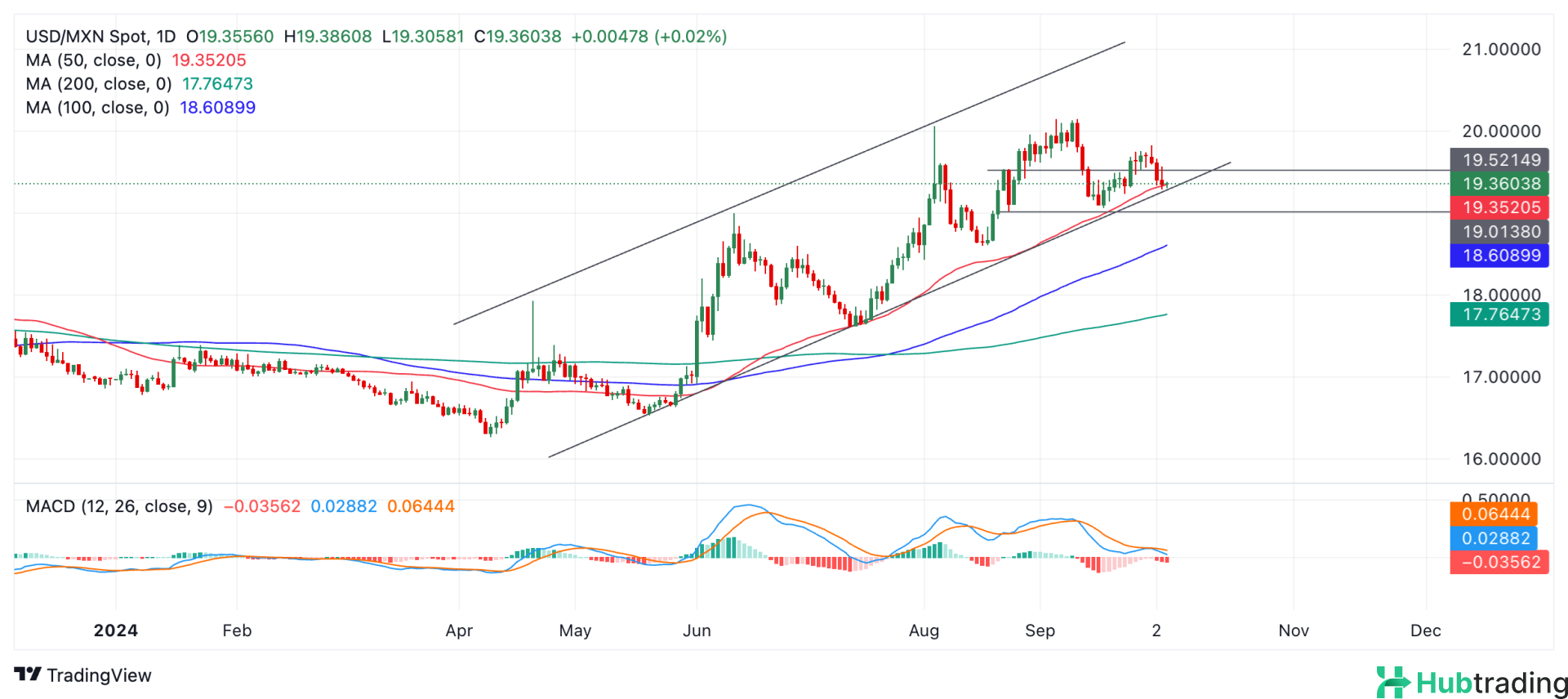- The Mexican Peso shows mixed performance following four days of gains.
- The upward movement is attributed to the Supreme Court's decision to revisit controversial reforms and comments from a Banxico official.
- USD/MXN has dropped to crucial support at the bottom of its rising channel and the 50-day SMA.
The Mexican Peso (MXN) experiences minor fluctuations in both gains and losses during the European session on Friday, following four consecutive days of upward movement across its three most-traded pairs: USD/MXN, EUR/MXN, and GBP/MXN.
This strength can be attributed initially to comments made by Deputy Governor of the Bank of Mexico (Banxico), Jonathan Heath, who indicated on Tuesday that interest rates should remain elevated for a longer duration. Higher interest rates tend to attract more foreign capital inflows, bolstering the Peso. Additionally, news regarding a Supreme Court decision to revisit and possibly revise controversial judicial reforms further fueled the Peso's rally.
Notably, the Peso is currently hovering around the 50-day Simple Moving Average (SMA) in all three key pairs, a technical indicator that institutional investors often consider when making decisions.
Mexican Peso Strengthens Following Supreme Court Action
On Thursday, the Peso gained traction after reports emerged that Mexico's 11 Supreme Court judges voted 8 to 3 to re-evaluate controversial constitutional reforms to the judiciary, which were enacted by the government in September. This decision could potentially hinder the implementation of reforms aimed at transitioning from appointed judges to elected ones, as reported by El Financiero.
The Mexican financial markets faced significant challenges in June following the election of the Morena-led government, raising investor concerns over these and other proposed reforms. This situation contributed to a 10% depreciation of the Peso. Critics have voiced that such reforms threaten judicial independence, are anti-democratic, and could deter foreign investment.
Despite the recent challenges, Mexican assets, including the Peso, currently maintain an investment-grade rating from all three major rating agencies, according to Kimberley Sperrfechter, Emerging Markets Economist at Capital Economics. However, she warned that if the judicial reforms lead to a notable decline in institutional quality, weaker economic growth, and insufficient tightening of fiscal policy, there could be a risk of a downgrade in the medium term.
The push to re-examine these reforms has been led by Supreme Court Judge Juan Luis González Alcántara, who cited concerns that the new laws could undermine judicial independence. While the Supreme Court lacks the authority to annul these laws, it does have the power to determine if revisions are necessary. In response, Marti Luis Batres, Head of the Government of Mexico City, described the Supreme Court's move as a "coup d'état."
Technical Analysis: USD/MXN Reaches 50-Day Moving Average
The USD/MXN has retraced to the bottom of its rising channel, coinciding with the 50-day Simple Moving Average (SMA), which serves as a critical level for traders to watch.
USD/MXN Daily Chart

The USD/MXN is anticipated to find support at the 50-day Simple Moving Average (SMA), with a possibility of rebounding and resuming its upward movement within the established range. Both the medium and long-term trends appear bullish, and adhering to the technical analysis principle of “the trend is your friend,” the likelihood of a recovery and continued ascent is promising.
However, the short-term trend currently shows bearish characteristics, particularly as the GBP/MXN has already broken below its rising channel. This can often serve as a “canary in the coal mine,” signaling potential weakness for other Peso pairs.
A decisive breach beneath both the rising channel and the 50-day SMA could jeopardize the medium-term bullish trend for the USD/MXN. Such a downward movement would be marked by a longer-than-average bearish candlestick that cleanly pierces through both the channel line and the SMA, closing near its low. If this scenario unfolds, it could pave the way for further declines, initially targeting the round number at 19.00 (the August 23 low) and subsequently the 100-day SMA at 18.60.





